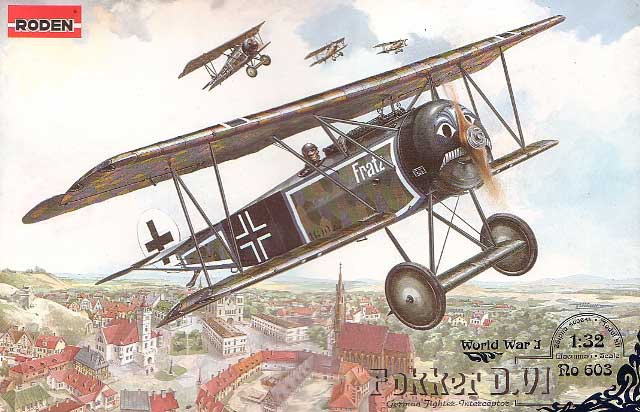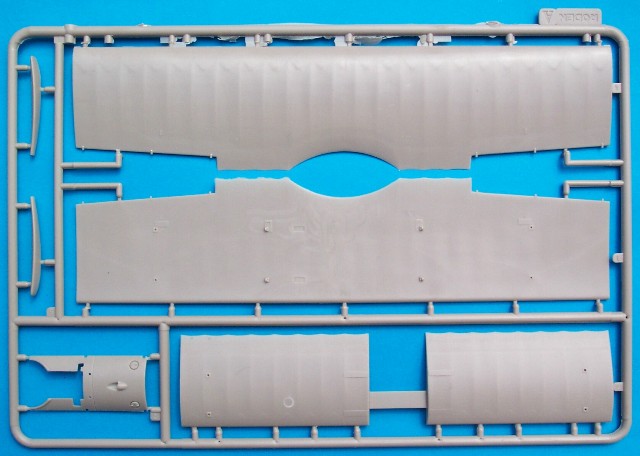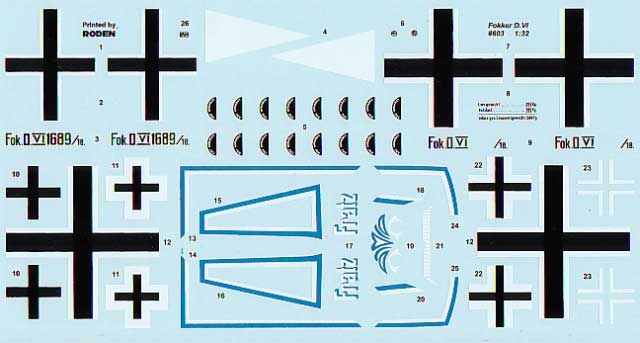|
Fokker D.VI

Roden 1/32
S
u m m a r y
|
| Catalogue Number: |
Roden Fokker D.VI kit #603 |
| Scale: |
1/32 |
| Contents and Media: |
Over 100 parts in injection moulded
plastic; markings for three aircraft |
| Price: |
USD$33.96 from Squadron.com
|
| Review Type: |
FirstLook |
| Advantages: |
Excellent moulding, good detail,
decals in register, subtle rib detail, sharp trailing edges. |
| Disadvantages: |
No cowling detail, step in tailplane. |
| Recommendation: |
Recommended |
Reviewed by Robert Baumgartner

Roden's 1/32
scale Fokker D.VI is available online from Squadron.com
The Adlershof test centre was
the venue of the first fighter competition and was held from the 20th
January to the 12th February 1918. It was here that the
forerunners to the Fokker D.VI made their first public appearance. The
three aircraft used did not fair very well, this being due to engines
that were either poor running or experimental in nature.
However, sufficient faith was
placed in the airframe for Idflieg to place a production contract
numbering 120 machines. These were to be powered by the reliable 110hp 9
cylinder Oberursel Ur II engine which was essentially a copy of the
French 110hp Le Rhöne. Only 60 Fokker D.VI were delivered as production
later switched to the Fokker E.V, which had made such an impressive
impression at the second fighter competition.
The similarity between the
subject kit and the Fokker Dr.I is obvious so it is not surprising that
Roden have used that kit as a basis for this latest issue.
From the previous release, sprue
D has been altered and incorporates the different ailerons and “N”
struts. This is also the case with sprue B which now holds the under
surface of the lower wing as well as the undercarriage and cabane
struts.
Sprue E remains unchanged as
does sprue C. Naturally a new sprue is needed for the parts exclusively
for the D.IV and this is sprue A. It contains the upper wings, forward
decking and the other half of the lower wing.

Click
the thumbnails below to view larger images:
Due to the commonality of the
parts, there are a couple of issues carried over from the Dr.I. The
first is the bogus step on the tailplane and the other is the cowling
which sadly lacks any detail.
Some will choose to reduce the
span of the axle wing slightly but of more importance is the elimination
of the under surface straps.
The wings are superb and exhibit
a fine rendition of the ribs and forward plywood sheathing. They come as
separate upper and lower halves but despite this, the completed assembly
will have very thin trailing edges.
Separate ailerons are a bonus
and the method of inserting the control horns will ensure rigidity.
Accuracy is not a problem with
the flying surfaces as they match very well with Martin Digmeyer’s 2000
plans. Do note however, that his plans showing the upper wing aileron
hinges are in a different position from those in his structural
drawings. Roden adhered to the former.
The cockpit contains the usual
fare with seat, floor, compass, control column and rudder bar all
supplied. A nice hand grip is also featured, along with hand pump,
fuel/oil tank and ammunition cans.
Separate structural detail is
provided in the form of a moulded tubular framework and to this has been
added the auxiliary throttle control. The missing triangular plywood
side fairings will have to be added in the cockpit area but this is
easily done with plastic card. Two unproblematic ejection plugs need to
be removed before this can be done.
There are no problems with the
filler caps as both have been detailed on the upper deck.
The rotary engine is a nice
affair with the cylinder ends being separate items. This is a fantastic
idea as it takes away the drama of a nasty clean-up operation on any
join lines.
To compliment this assembly,
both Axial and Garuda airscrews are offered.
A very good pair of machine guns
is available to the builder and will come up superbly with the
appropriate paint job. For those that choose to use an after market
photo etched jacket, Roden have moulded a version for that option as
well. There are a couple of sink marks on these items however, so
careful filling is necessary.
Lately this manufacturer has
made great strides by the improvement of their rigging diagrams. There
is no exception here with a full page being devoted to this task.
There will always be a debate
over the colours used in the “lozenge” pattern applied to German
aircraft. The rendition given by Roden in this kit is a vast improvement
on the garish colours that used to be presented to the modeller. They
are broken down into “bolts” that can be orientated to whichever
direction the builder sees fit.

Click
the thumbnails below to view larger images:
Three schemes are catered for
and offer the constructor a pleasant variety of options.
-
Fokker D.VI
1689/18, Flugpark Armee Abteilung B based in the Alsace-Lorraine
sector, June 1918.
-
Fokker D.VI of
home defence Staffel Kest 1a based at Mannheim, 1918.
- Fokker D.VI “Fratz” piloted
by Leutnant Kurt Seit of Jasta 80b, 1918.
Seit
actually made “acedom” with five victories, all with Jasta 80. He was
wounded four times during the war but survived to become a dentist in
Stuttgart.
In my example the three decal
sheets were well printed with no apparent registration problems. The
glossy carrier film was very thin with a sample application causing no
problems whatsoever.
This is certainly an interesting
subject and one that seemed destined to never be done in this scale.
With the interesting markings selection and ease of assembly, it will
undoubtedly appeal to World War 1 modellers.
Recommended
Thanks to
Squadron.com for the review
sample.
Review and Images Copyright © 2005 by
Robert Baumgartner
Page Created 26 September, 2005
Last updated 25 September, 2005
Back to HyperScale Main Page
Back to Reviews Page
|
Home | What's
New | Features
| Gallery |
Reviews | Reference
| Forum
| Search